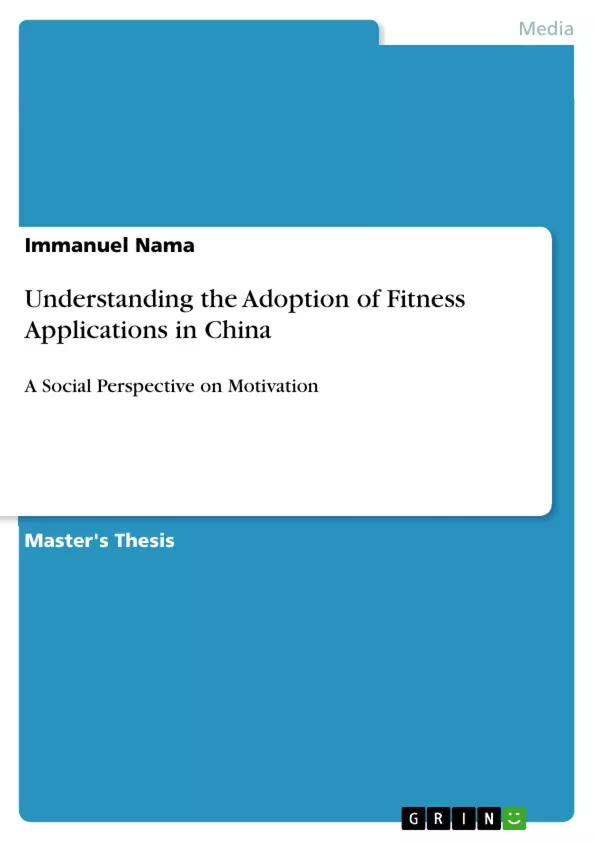Understanding the adoption of fitness applications is a complex process as it is closely linked with people’s health behaviors and under the influence of manifold of influential forces. This research is focusing on the social perspective on motivation while not neglecting an adoption driven by the need that is concentrated on the mere functionality of an app. The main objective of the research is to discover the underlying social motivation and propensity of users to adopt fitness applications in China. The central question is whether the willingness to adopt a fitness app is being influenced solely by the need to track one’s activities with the help of a tool or if social motivation is playing an essential role in influencing a person’s inclination to adopt this kind of applications. The problem this thesis is trying to understand better is the propensity of people in the initial adoption phase of a fitness application. So, it can be said that the scope of the study is narrowing down the general idea of health to the specific scenario of fitness applications.
The main idea and assumption is that social motivation in the adoption of fitness apps is playing the essential role and has to be given great consideration by marketers and businesses. The findings can be adapted to business practices and marketing efforts. The 532 answers gathered in the survey have been looked at from an approach that stays close to the theories leveraged in the development of the variables as well as a model-approach that constructed the possible relationship between the variables. The variables constructed are based on the theories of the lazy user (Need N), social status (SS), social influence (SIN) as well as social impact (SIM).
Need N is trying to minimize efforts in an adoption process in order to gain the required functions of an application. Following social status (SS) as a motivator, a person is intrinsically motivated to pursue a goal-directed behavior, in this case, the adoption of a fitness application, in order to adjust, maintain or obtain a perceived social status by others. On the other hand, social influence (SIN) focuses on the external influential stimulusthat is being exerted on the individual and can be separated into the two modes of identification and internalization.
Inhaltsverzeichnis (Table of Contents)
- 1. Introduction
- 1.1 Background: Fitness in China - a Snapshot of Current Developments
- 1.2 Research Questions
- 1.3 Significance of the Study
- 1.3 Schematic Outline of the Thesis
- 2. Literature Review - Theoretical Background
- 2.1 Definitions: Fitness and Fitness applications
- 2.2 Theory behind the Willingness to Adopt (WTA) a Fitness App
- 2.3 Related Theories
- 2.3.1 Need N
- 2.3.2 Social Status SS
- 2.3.3 Social Influence SIN
- 2.3.4 Social Impact SIM
- 2.4 Justification of Theories
- 3. Modeling the Fitness App Adoption
- 3.1 Social Variables of Motivation
- 3.2 Research Model and Hypotheses Development
- 3.3 Questionnaire Design and Data Collection
- 4. Results
- 4.1 Model-free explanations
- 4.2 Model explanations
- 5. Discussion and Conclusion
Zielsetzung und Themenschwerpunkte (Objectives and Key Themes)
This research investigates the motivations behind the adoption of fitness applications in China, specifically exploring the role of social factors. The study aims to understand whether the adoption of fitness apps is driven solely by the functional need for tracking activities or if social motivations play a significant part.- The influence of social status on the adoption of fitness apps in China.
- The role of social influence and social impact in influencing users' decisions to adopt fitness applications.
- The impact of social motivations compared to the need for functionality in fitness app adoption.
- The application of theoretical frameworks like the "lazy user" concept, social status theory, social influence theory, and social impact theory in understanding fitness app adoption.
- The implications of the research findings for marketers and businesses in the fitness app sector.
Zusammenfassung der Kapitel (Chapter Summaries)
- The introduction chapter presents a brief overview of the fitness industry in China, highlighting the rising interest in healthy living and the government's support for promoting fitness activities. It also introduces the research questions and the significance of the study.
- The literature review chapter delves into the theoretical background of the research, defining fitness and fitness applications and exploring theories related to the willingness to adopt (WTA) a fitness app. It specifically examines theories like the lazy user (Need N), social status (SS), social influence (SIN), and social impact (SIM) in relation to fitness app adoption.
- The third chapter focuses on the modeling of fitness app adoption. It discusses the social variables of motivation, outlines the research model and hypothesis development, and details the questionnaire design and data collection process.
- The results chapter presents both model-free explanations and model explanations based on regression analysis. It analyzes the relationships between the variables postulated in the research hypotheses.
Schlüsselwörter (Keywords)
The research focuses on the adoption of fitness applications in China, exploring the role of social motivations, social influence, and social impact. Key terms include: willingness to adopt fitness apps, social status, social impact, social influence, social motivation, and need.- Quote paper
- Immanuel Nama (Author), 2019, Understanding the Adoption of Fitness Applications in China, Munich, GRIN Verlag, https://www.grin.com/document/494242



